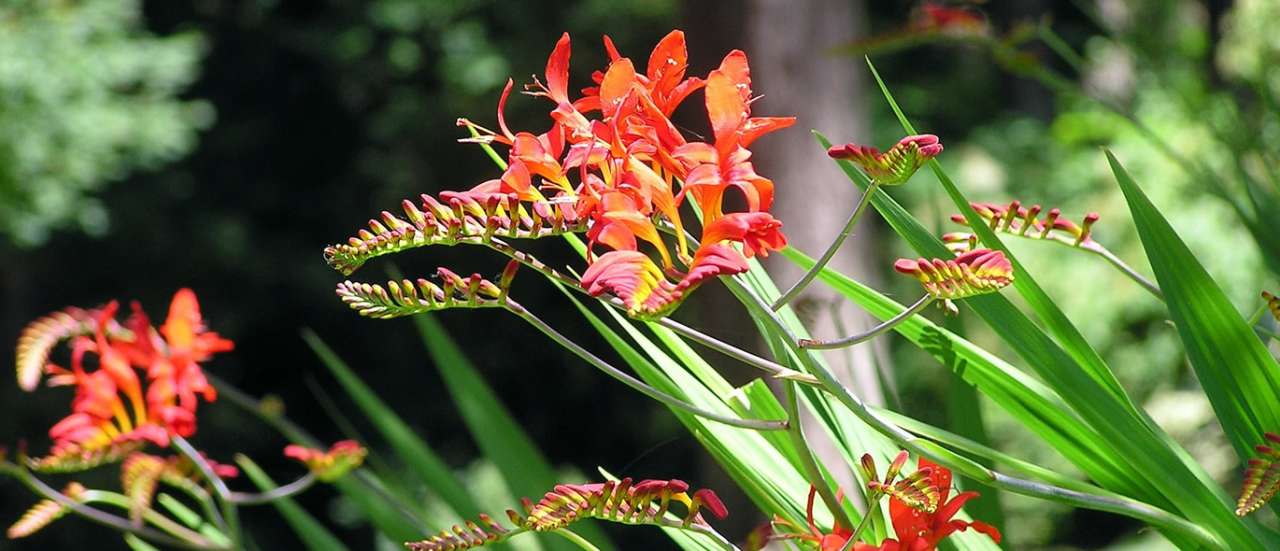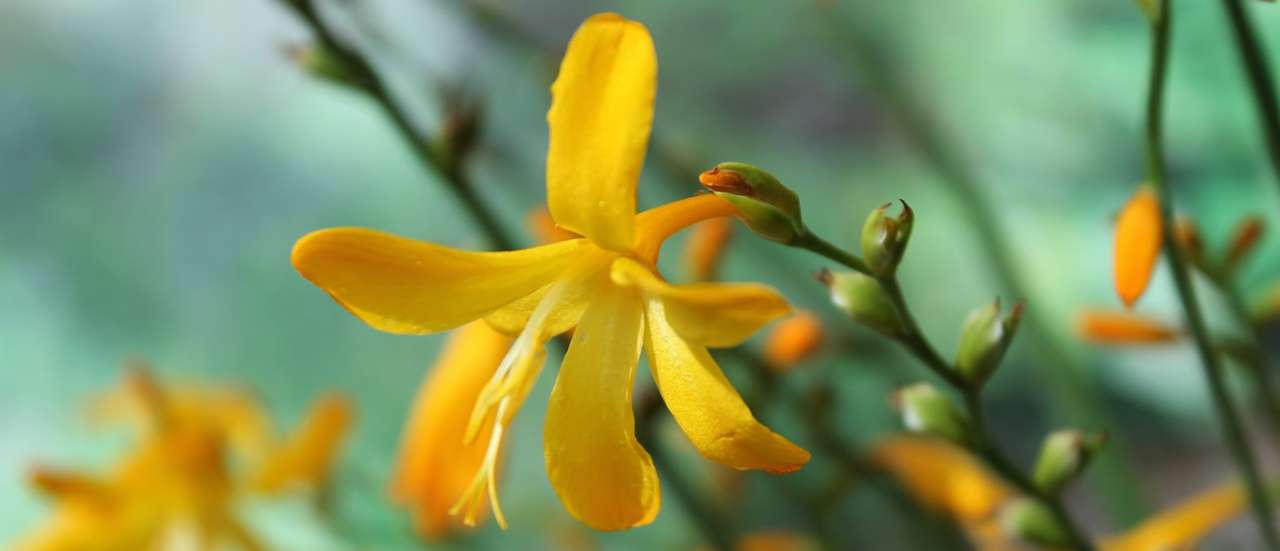Crocosmia, are also referred to as montbretia, although this more accurately relates to the common species Crocosmia x crocosmiiflora, which can often be seen brightening up some of our Irish hedgerows. The cultivars that are sold in our garden centres are not considered to be invasive like the common variety. All crocosmia grow from corms, which are similar to bulbs, and will spread by forming new corms each year. For anyone concerned about their potential invasive nature, these plants are easy to control as they are shallow rooted and so if they do spread beyond the desired area, the extra corms can easily be dug up (and as a bonus these can then be planted elsewhere in the garden or in a container to provide you with extra plants!).
These popular perennial plants are available in fiery shades of red, yellow and orange with sizes ranging from around 60cm to 2m in height. Their flowers are produced from early to mid-summer and can last well into the autumn, brightening up your garden at a time when many perennials have passed their peak. The strappy foliage also provides attractive greenery from late spring until it dies back in winter and sits well in mixed borders, looking particularly fitting in prairie style planting schemes mixed with other grasses . If you are going for a more tropical look they can really turn up the heat mixed with the likes of kniphofia, heleniums and rudbeckia. They also make a great cut flower and for the wildlife lovers, they are loved by bees, providing them with valuable nectar and pollen later in the season.

Where and How to grow:
Crocosmia are a low maintenance perennial, that will grow in pretty much all soil types as long as the soil is moist and well drained i.e. they don't like extremes of dryness (not too much of a concern in Ireland) nor will they tolerate sitting in waterlogged soil as, similar to bulbs, if they sit in water for too long the corms are prone to rot. They will also put up with some shade, although we would advise you to plant them in a sunny position as this is where you will get the most flowers,
One of the main things to pay attention to when buying crocosmia, is their size. Whilst the intense red of a variety like 'Lucifer' might be eye-catching, the flowers tend to form on stems over a meter tall, hovering over a clump of strappy leaves that are almost as tall as those flower stems, so these would tend to be better near the back of a border and given plenty of space, so as not to overshadow any other nearby perennials. Smaller varieties like 'George Davidson' or 'Emily Meckensie' come in smaller at a height of up to 60cm with a similar spread and so would do well at the mid-level of a border. The latter two varieties can even be grown in containers, forming neat clumps of bright green grassy foliage before flowering in late summer.
If you do get hold of crocosmia corms, these can be planted just like bulbs in the spring. Dig over the planting area, allowing space for the corms to be planted a few centimeters apart. Fork through some compost, planting the corms about 7-10cm deep and cover with soil.
It is more common to find crocosmia as potted plants and these can be planted any time from spring through to autumn as they adapt and settle very quickly, becoming fully established within the first year.
- Fork through the area you intend to plant your crocosmia, removing any weeds and adding some organic matter (compost etc) to boost fertility, water retention and drainage.
- Dig a hole as deep and just a little wider than the pot, remove your plant from its pot, position in the hole, backfill and gently firm in. Give it a good initial watering and that's it.
- If planted early enough they should flower in the first year and for many years to come!
Crocosmia care:
Crocosmia require very little care at all. When they are initially planted it is worth making sure they are watered regularly but once the foliage appears pretty strong and healthy, there really should be no need for additional watering unless we have a particularly long dry spell or 'heatwave'. Container grown plants will need more watering and the compost should be kept moist but not waterlogged.
In terms of feed, this shouldn't be necessary in the garden although an annual dose of an all purpose fertiliser wouldn't do any harm in the spring. Again, for container plants, this is a little different and we would recommend giving them a boost with a fortnightly dose of liquid tomato-feed or other high-potassium feed (like home made comfrey feed) through the summer to encourage flowering.
Other than that, just a good mulch of organic matter in late autumn will do them wonders.
Propagation:
Because these plants spread by corm, these can become quite congested and may need dividing every three to five years anyway to revitalise them. This can be done by digging up the corms whilst they are still dormant in spring and dividing them up and respacing and replanting. Any excess corms can then be replanted elsewhere in smaller groups.
Crocosmia Companions
If you're looking to create a more tropical, hot border then crocosmia pair perfectly with kniphofia, heleniums and dahlias as these come in equally 'hot' colours and also flower later in the season. A large dark leaved canna (like 'Durban') can also provide a beautiful backdrop in the summer months to really give that tropical feel.
For more of a cottage garden feel, with contrasting colours, salvias, agapanthus and geraniums are ideal bed-fellows whilst mixing with a variety of ornamental grasses is perfect for a prairie style planting scheme.
Whatever the look you are going for, crocosmia are a hassle free, versatile perennial that will bring vibrant colour to your garden year after year.









